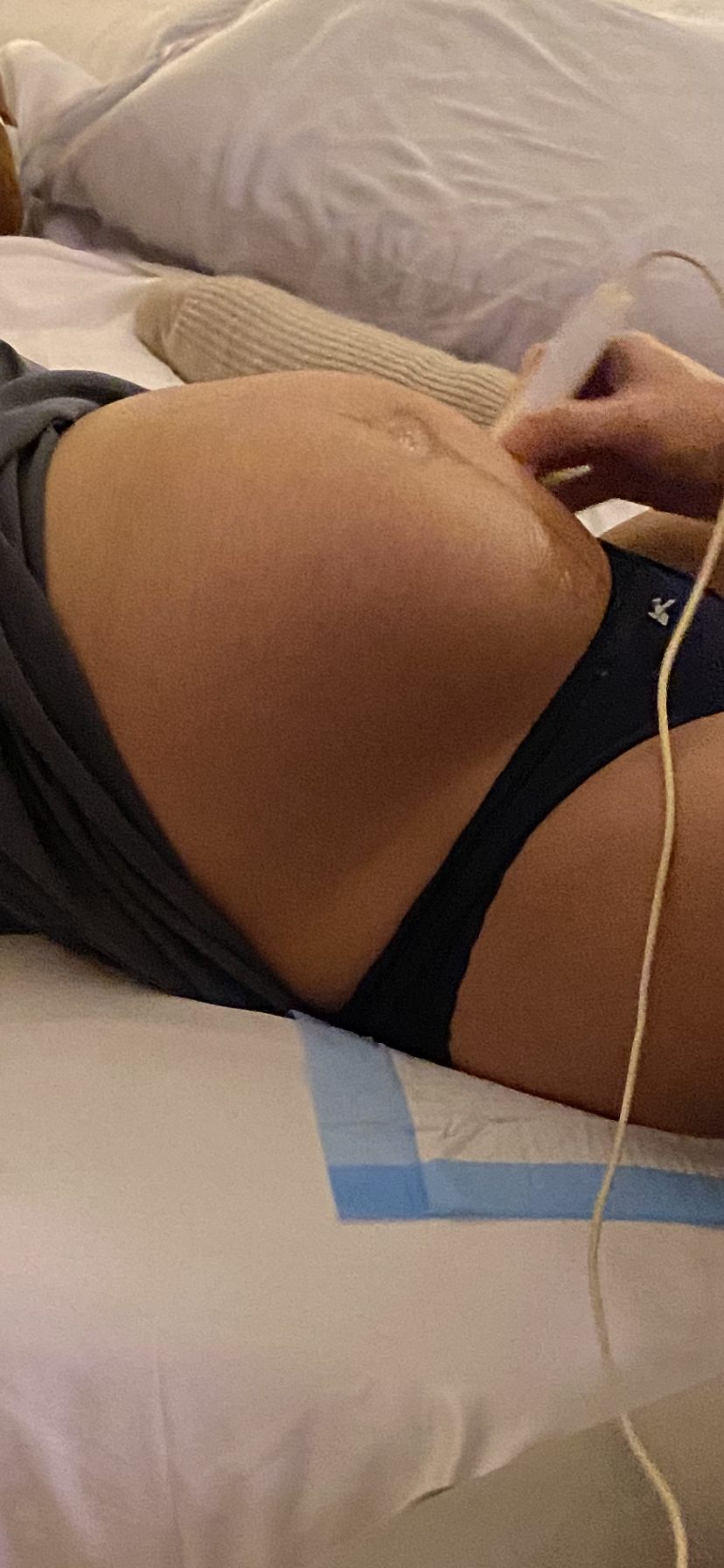How do you know when to use OMP Reversing Protocols?
Whether you are a parent or a birth professional, this is a common question often asked during labor “How do I know when it’s not going well?” The aim is to notice it as soon as the body starts communicating that labor is not progressing so whilst the laboring mother still has energy to be pro-active in getting baby to turn and/or labor to progress using non-pharmaceutical methods before resorting to medical interventions.
Posterior Position
When a baby is in a posterior lie, it is sometimes physically obvious when the mother is lying on her back.In this photo, you can see that there is a ‘dip’ from the mother’s belly button to her ‘public arch, and the ultrasound confirmed that this baby’s spine was in LOP and its head was in LOT-LOA.
In our OMP website under ‘Labor & Birth’, we have a page titled ‘How do you know you are in labor?’ where we write about the difference between recognising a normal versus abnormal labor. One of the key learnings I took away from my interactions with Midwife Nicole Morales is the importance of first understanding what is normal before we delve into the variation from normal.
What is normal?
No matter what early signs of labor a laboring mother has, she needs contractions for labor to progress in a full term labor. We don’t just want regular contractions, we want contractions with a progressive and/or symmetrical labor patterns.
Progressive labor patterns means that over a period of time, we notice that:
Frequency of the contractions gets closer and closer over a period of time;
Duration of the contractions gets longer and longer over a period of time;
Intensity of the contractions gets more and more intense over a period of time;
Physical signs of Labor: Early signs of labor matched with early labor patterns; active signs of labor ie. more and more bloody show, the urge to have a bowel movement during contractions, purple line, talking anus etc
For a first time mother, we are expecting (1) + (2) + (3) to occur concurrently, matched with the appropriate physical signs of labor. You can have a first time mother experiencing contractions every 8-10minutes apart, about 20-30 seconds long and they are crazy intense. (1) and (2) sounds normal, yet she should not be experiencing such intensity when contractions are still 8-10minutes apart. So the moment one factor is “off”, it can be indicative that something is not right.
For a second time or more mother, we only pay attention to (2) and (3). As soon as the contractions are about 60 seconds long and they are intense, it may not be long before this baby is making its appearance.
A mother’s contraction patterns, her physical signs and how she is coping with labor are all clues as to whether this mother is progressing or not.
If the mother’s labor is progressing, she can choose to still use OMP Pelvic Alignment Protocols as a “maintenance” for just-in-case to ensure that all is going well during labor. She is encouraged to use the OMP Pelvic Mobility Protocols throughout labor.
If a mother’s labor is not progressing and she is experiencing abnormal and/or asymmetrical labor patterns such as:
Fast & Furious Labor Pattern | The moment contractions start, they are coming every 2-5minutes in frequency, they are more than 60 seconds long, and they are very intense. From a pain scale of 0-10, 10 being the most intense - the mother reports feeling as if she started from nothing and escalated to 6-8 on the pain-scale or more.
Start-Stop and/or erratic labor patterns | There is no pattern. When using a contraction timer, you are unable to see a contraction pattern because the frequency varies, the duration varies, and the intensity varies. You are unable to report that contractions are coming every 5 minutes, about 60 seconds long, and relatively intense. They are simply all over the place. The moment she changes position and/or when the sun goes down, everything stops. Sometimes it will seem like there is a pattern, they are coming every 6-8 minutes, they are 40-50 seconds long however they are extremely intense to the point where the laboring mother has hit the wall. So (1) & (2) is symmetrical however (3) is asymmetrical and there are no (4) physical signs to match.
Prodomol Labor | Whilst it seems acceptable that a long early labor can be common for some women, I would still monitor labor patterns and physical signs of early labor to see if the prodomol labor is showing signs of a symmetrical or asymmetrical labor pattern.
Back Labor | At some point during labor, most women would experience back pain together with the contractions as the pelvis opens up to create space for their baby. Back pain is an alarm bell when the intensity of the back discomfort overtakes the intensity of the contractions, and is matched together with either fast & furious labor patterns or haphazard and/or erratic labor patterns, this is when we suspect that the baby is malpositioned or malpresented.
You can have a laboring mother start labor with abnormal labor patterns and progressing to progressive labor patterns when techniques are used to rectify the issues or you can have laboring moms start labor with progressive labor patterns and changing to abnormal labor patterns when they hit a roadblock.
The key is to learn how the body is communicating with you to tell you whether labor is progressing or not.
And of course we will encounter non-textbook cases where the labor patterns are not giving you the information you are looking for, which is also why it is very important to watch the body. The physical signs of labor (4) will indicate whether this mother in showing physical signs of early labor or active labor. If she is showing signs of active labor even if the labor patterns don’t match “textbook”, listen to her body!
How to use OMP Reversing Protocols?
If you suspect that labor is not progressing due to abnormal and/or asymmetrical labor patterns, you are encouraged to get the laboring mother to utilise the following protocols to shift her abnormal and/or asymmetrical labor patterns back to normal and/or symmetrical labor patterns.
Firstly understand the concepts of the important of getting her hot air balloon in dynamic equilibrium and trouble shooting labor and birth
Secondly, we use ‘reversing’ for 15-30mins of total ‘downtime’. In reality, this can take more than an hour to achieve 15-30mins of total downtime as the laboring mother usually needs breaks in-between.
Thirdly, use OMP Pelvic Alignment Procotols to untwist and bring her hot air balloon back into alignment.
Whether you only use one of out the six protocols, some or all will be dependent on the intent that you are trying to achieve and what the laboring mother is able to do. If unsure, use all or simply 1.1 PSLR - PSLR usually being the miracle worker. It is important to have these protocols done in-between and during contractions and for at least 3-5 contractions on each side before you see the magic of OMP protocols unfold.
After doing one set - whenever you had in mind for one set of OMP Reversing Protocols and OMP Pelvic Alignment Protocols - get a mother to ‘rest’ if possible or use a comfort measures such as having a warm shower etc.. whilst timing 3-5 consecutive contractions to see if the body resets (it is common for the contractions to stop and the body to take a break before resuming) and if the labor patterns have progressed to symmetrical labor patterns or are still asymmetrical.
If the labor patterns have progressed to symmetrical labor patterns, move to the next step. If the labor patterns are still asymmetrical, repeat another set of OMP Reversing Protocols + OMP Pelvic Alignment Protocols until the mother’s labor progresses.
If the mother’s labor has progressed, use the OMP Pelvic Mobility Protocols to open and create space within the pelvis for this baby to be born!
How to you know when to stop using OMP Reversing Protocols?
You stop when the contraction patterns have shifted to normal and/or symmetrical labor patterns or simply if labor progresses! From this point forward, focus on using OMP Pelvic Mobility Protocols to open and create space within the pelvis for this baby to be born!

